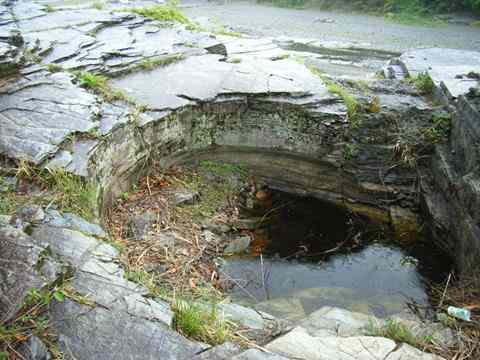Oyahana Bridge
Oyahana, Minano city, Chichibu county, Saitama pref., Japan
Closed to collecting as it is a natural monument.
Occurrence
Greenschist facies bedded manganese deposit
Sanbagawa Metamorphic Rocks subjected to Greenschist facies metamorphism. The protolith is the chert-hosted bedded manganese deposit.

Outcrop of piemontite schist of Sanbagawa Metamorphic Rocks. The shistosity of this piemontite schist outcrop is approximately parallel to the ground surface. This outcrop looks pink by fine piemontite crystals included. The large cylindrical hole is a pot hole. A bolder trapped in a fracture was rotated by water flow and drilled the rock.
The pot hole at this location was described in 1906.
Reported Minerals
- Piemontite
- Braunite
Mineral Assemblages
- Quartz - Piemontite - Muscovite
History
- This outcrop has been called as Otome-Iwa which means young girl rock.
- 1888: Prof. Bunjiro Koto, Japanese petrologist of the University of Tokyo, first described piemontite in schist from Japanese localities including this outcrop.
- 1906: Dr. Denzo Sato, Japanese archaeologist and petrologist, first described the pot hole in Japan.
- 1924: Registered as a natural monument.
Localities
- Tone Mine (Braunite, High-P)
- Oyahana Bridge (Piemontite, High-P)
- Tsukiyoshi (Piemontite, High-P)
Related Occurrences
- Bedded Mn (Diagenesis)
- Bedded Mn (Low-T zeolite facies)
- Bedded Mn (High-T zeolite facies)
- Bedded Mn (Prehnite-Pumpellyite facies)
- Bedded Mn (Pumpellyite-Actinolite facies)
- Bedded Mn (Greenschist facies)
- Bedded Mn (Epidote-Amphibolite facies)
- Bedded Mn (Amphibolite facies)
- Bedded Mn (Albite-Epidote-hornfels facies)
- Bedded Mn (Hornblende-hornfels facies)
- Bedded Mn (Pyroxene-hornfels facies)